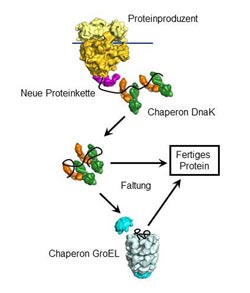The Dance of the Chaperones – Max Planck Scientists Identify Key Player of Protein Folding

The chaperone DnaK binds to new proteins and mediates their folding. Proteins it cannot fold, DnaK transports to GroEL, a highly specialized folding machine. Grafic: F.-Ulrich Hartl / Copyright: MPI of Biochemistry<br>
To fulfill their tasks they need to be folded into a complicated three-dimensional structure. Scientists from the Max Planck Institute of Biochemistry (MPIB) in Martinsried near Munich, Germany, have now analyzed one of the key players of the folding process: the molecular chaperone DnaK.
“The understanding of these mechanisms is of great interest in the light of the many diseases in which folding goes awry, such as Alzheimer’ or Parkinson’s” says Ulrich Hartl, MPIB director. Their work has now been published in Cell Reports.
Proteins are responsible for almost all biological functions. The cells of the human body continuously synthesize thousands of different proteins in the form of amino acid chains. In order to be biologically useful, these chains must fold into a complex three-dimensional pattern. When this difficult process goes wrong, it can lead to useless or even dangerous protein clumps. All cells, from bacteria to human, have therefore developed a network of molecular chaperones, themselves proteins, which help other proteins to fold properly.
MPIB scientists have now investigated the organization of this network in the bacterium Escherichia coli. Using proteomic analyses they show how different chaperones cooperate during the folding process. “We identified the Hsp70 protein DnaK as the central player of the network,” explains Ulrich Hartl. “It functions as a kind of turntable.” DnaK binds to about 700 different protein chains as they are synthesized. Furthermore, DnaK mediates the folding of most of these protein chains. Those it cannot fold are transferred to yet another chaperone, the barrel-shaped GroEL. GroEL is a highly specialized folding machine. It forms a nano-cage in which a single protein chain is temporarily enclosed and allowed to fold while protected from external influences.
Disruptions in the Chaperone Network
The researchers also investigated what happens when the chaperone network is disturbed. For example, when GroEL is removed from the cells, its client proteins accumulate on DnaK, which then shuttles them to proteases to be decomposed. “Apparently, DnaK realizes that the attached protein chains will never be able to mature into useful molecules,” says the biochemist. Similar but even more complicated chaperone networks control the proteome of human cells. Understanding these reactions is of great interest in the light of the many neurodegenerative diseases in which folding goes awry.
Original Publications:
G. Calloni, T. Chen, S.M. Schermann, H. Chang, P. Genevaux, F. Agostini, G.G. Tartaglia, M. Hayer-Hartl and F.U. Hartl: DnaK Functions as a Central Hub in the E. coli Chaperone Network. Cell Reports, March 8, 2012
DOI: 10.1016/j.celrep.2011.12.007
Contact:
Prof. Dr. F.-Ulrich Hartl
Cellular Biochemistry
Max Planck Institute of Biochemistry
Am Klopferspitz 18
82152 Martinsried
E-Mail: uhartl@biochem.mpg.de
Anja Konschak
Public Relations
Max Planck Institute of Biochemistry
Am Klopferspitz 18
82152 Martinsried
Phone ++49/89-8578-2824
E-mail: konschak@biochem.mpg.de
Media Contact
More Information:
http://www.biochem.mpg.deAll latest news from the category: Life Sciences and Chemistry
Articles and reports from the Life Sciences and chemistry area deal with applied and basic research into modern biology, chemistry and human medicine.
Valuable information can be found on a range of life sciences fields including bacteriology, biochemistry, bionics, bioinformatics, biophysics, biotechnology, genetics, geobotany, human biology, marine biology, microbiology, molecular biology, cellular biology, zoology, bioinorganic chemistry, microchemistry and environmental chemistry.
Newest articles

Superradiant atoms could push the boundaries of how precisely time can be measured
Superradiant atoms can help us measure time more precisely than ever. In a new study, researchers from the University of Copenhagen present a new method for measuring the time interval,…

Ion thermoelectric conversion devices for near room temperature
The electrode sheet of the thermoelectric device consists of ionic hydrogel, which is sandwiched between the electrodes to form, and the Prussian blue on the electrode undergoes a redox reaction…

Zap Energy achieves 37-million-degree temperatures in a compact device
New publication reports record electron temperatures for a small-scale, sheared-flow-stabilized Z-pinch fusion device. In the nine decades since humans first produced fusion reactions, only a few fusion technologies have demonstrated…





















